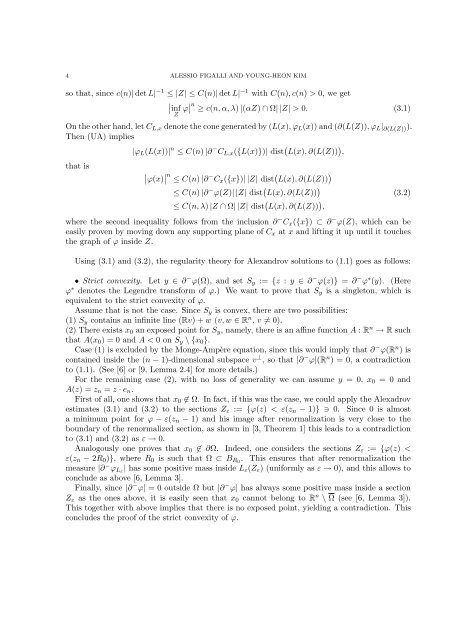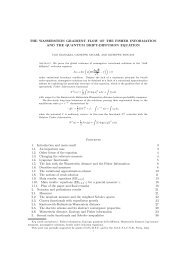Partial regularity of Brenier solutions of the Monge-Ampère equation
Partial regularity of Brenier solutions of the Monge-Ampère equation
Partial regularity of Brenier solutions of the Monge-Ampère equation
Create successful ePaper yourself
Turn your PDF publications into a flip-book with our unique Google optimized e-Paper software.
4 ALESSIO FIGALLI AND YOUNG-HEON KIM<br />
so that, since c(n)| det L| −1 ≤ |Z| ≤ C(n)| det L| −1 with C(n), c(n) > 0, we get<br />
<br />
inf<br />
Z ϕ n ≥ c(n, α, λ) |(αZ) ∩ Ω| |Z| > 0. (3.1)<br />
On <strong>the</strong> o<strong>the</strong>r hand, let CL,x denote <strong>the</strong> cone generated by (L(x), ϕL(x)) and (∂(L(Z)), ϕL| ∂(L(Z))).<br />
Then (UA) implies<br />
that is<br />
|ϕL(L(x))| n ≤ C(n) |∂ − CL,x({L(x)})| dist ( L(x), ∂(L(Z)) ) ,<br />
<br />
ϕ(x) n ≤ C(n) |∂ − Cx({x})| |Z| dist ( L(x), ∂(L(Z)) )<br />
≤ C(n) |∂ − ϕ(Z)| |Z| dist ( L(x), ∂(L(Z)) )<br />
≤ C(n, λ) |Z ∩ Ω| |Z| dist ( L(x), ∂(L(Z)) ) ,<br />
where <strong>the</strong> second inequality follows from <strong>the</strong> inclusion ∂ − Cx({x}) ⊂ ∂ − ϕ(Z), which can be<br />
easily proven by moving down any supporting plane <strong>of</strong> Cx at x and lifting it up until it touches<br />
<strong>the</strong> graph <strong>of</strong> ϕ inside Z.<br />
(3.2)<br />
Using (3.1) and (3.2), <strong>the</strong> <strong>regularity</strong> <strong>the</strong>ory for Alexandrov <strong>solutions</strong> to (1.1) goes as follows:<br />
• Strict convexity. Let y ∈ ∂ − ϕ(Ω), and set Sy := {z : y ∈ ∂ − ϕ(z)} = ∂ − ϕ ∗ (y). (Here<br />
ϕ ∗ denotes <strong>the</strong> Legendre transform <strong>of</strong> ϕ.) We want to prove that Sy is a singleton, which is<br />
equivalent to <strong>the</strong> strict convexity <strong>of</strong> ϕ.<br />
Assume that is not <strong>the</strong> case. Since Sy is convex, <strong>the</strong>re are two possibilities:<br />
(1) Sy contains an infinite line (Rv) + w (v, w ∈ R n , v = 0).<br />
(2) There exists x0 an exposed point for Sy, namely, <strong>the</strong>re is an affine function A : R n → R such<br />
that A(x0) = 0 and A < 0 on Sy \ {x0}.<br />
Case (1) is excluded by <strong>the</strong> <strong>Monge</strong>-<strong>Ampère</strong> <strong>equation</strong>, since this would imply that ∂ − ϕ(R n ) is<br />
contained inside <strong>the</strong> (n − 1)-dimensional subspace v ⊥ , so that |∂ − ϕ|(R n ) = 0, a contradiction<br />
to (1.1). (See [6] or [9, Lemma 2.4] for more details.)<br />
For <strong>the</strong> remaining case (2), with no loss <strong>of</strong> generality we can assume y = 0, x0 = 0 and<br />
A(z) = zn = z · en.<br />
First <strong>of</strong> all, one shows that x0 ∈ Ω. In fact, if this was <strong>the</strong> case, we could apply <strong>the</strong> Alexadrov<br />
estimates (3.1) and (3.2) to <strong>the</strong> sections Zε := {ϕ(z) < ε(zn − 1)} ∋ 0. Since 0 is almost<br />
a minimum point for ϕ − ε(zn − 1) and his image after renormalization is very close to <strong>the</strong><br />
boundary <strong>of</strong> <strong>the</strong> renormalized section, as shown in [3, Theorem 1] this leads to a contradiction<br />
to (3.1) and (3.2) as ε → 0.<br />
Analogously one proves that x0 ∈ ∂Ω. Indeed, one considers <strong>the</strong> sections Zε := {ϕ(z) <<br />
ε(zn − 2R0)}, where R0 is such that Ω ⊂ BR0 . This ensures that after renormalization <strong>the</strong><br />
measure |∂ − ϕLε| has some positive mass inside Lε(Zε) (uniformly as ε → 0), and this allows to<br />
conclude as above [6, Lemma 3].<br />
Finally, since |∂ − ϕ| = 0 outside Ω but |∂ − ϕ| has always some positive mass inside a section<br />
Zε as <strong>the</strong> ones above, it is easily seen that x0 cannot belong to R n \ Ω (see [6, Lemma 3]).<br />
This toge<strong>the</strong>r with above implies that <strong>the</strong>re is no exposed point, yielding a contradiction. This<br />
concludes <strong>the</strong> pro<strong>of</strong> <strong>of</strong> <strong>the</strong> strict convexity <strong>of</strong> ϕ.



